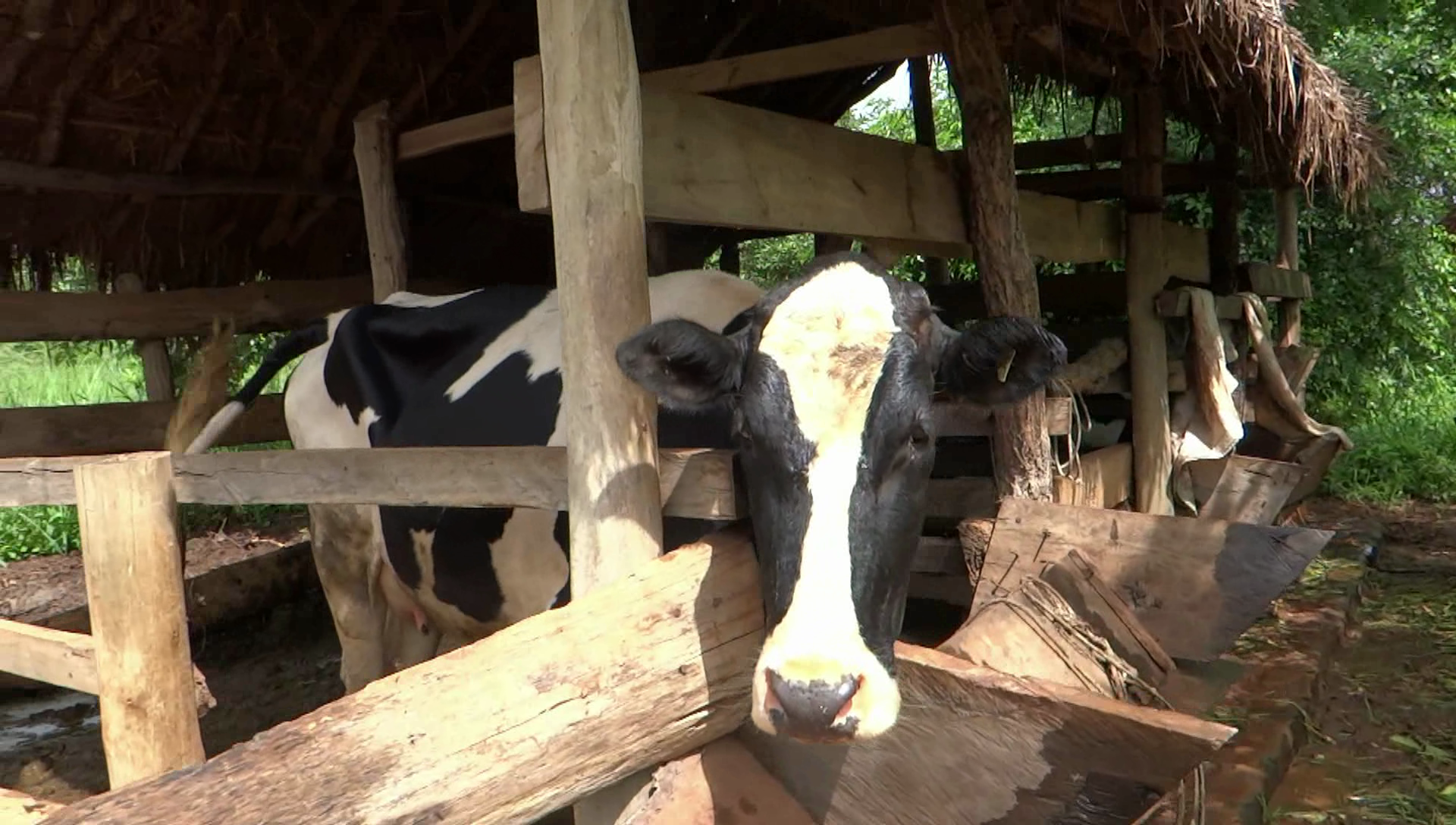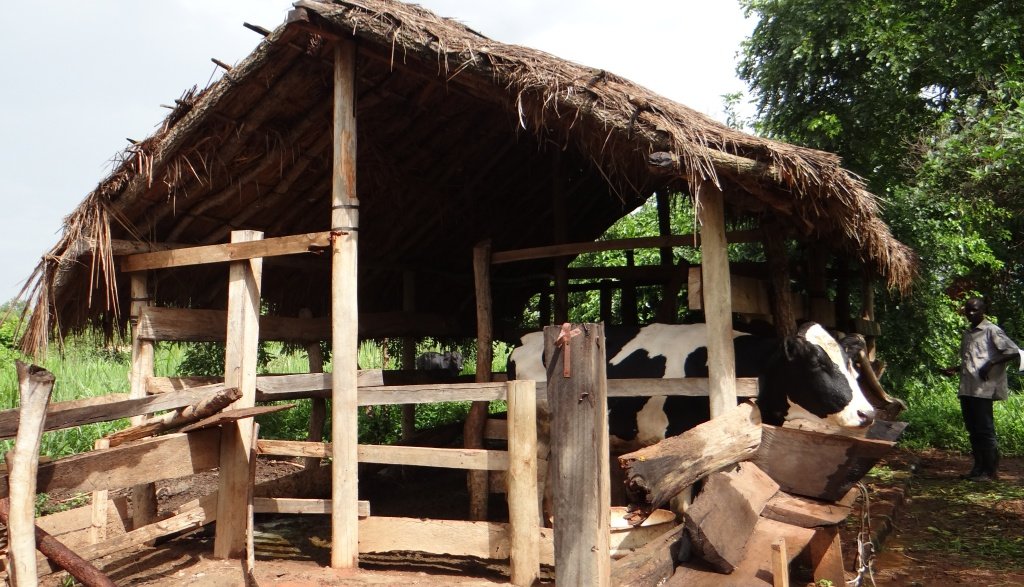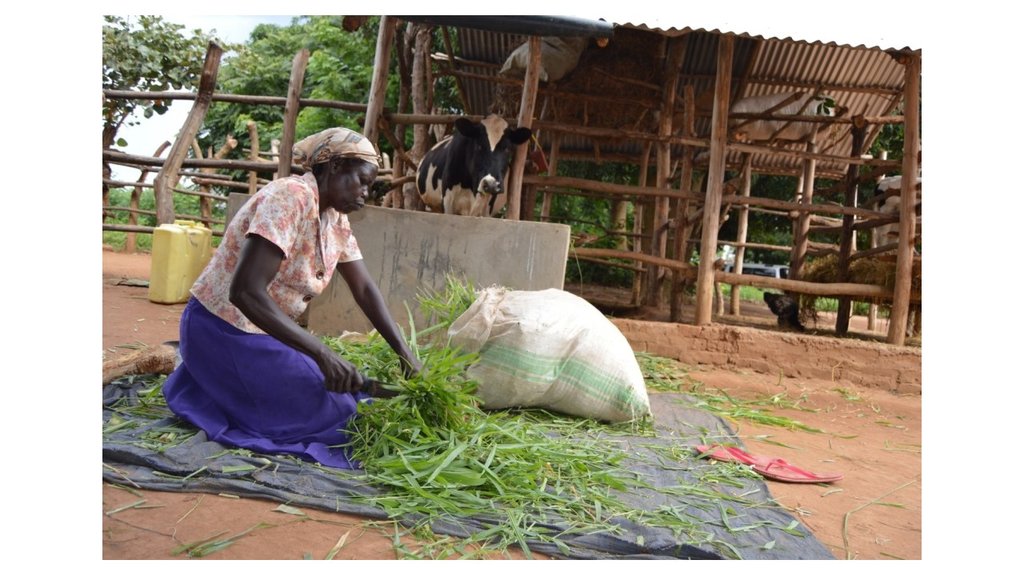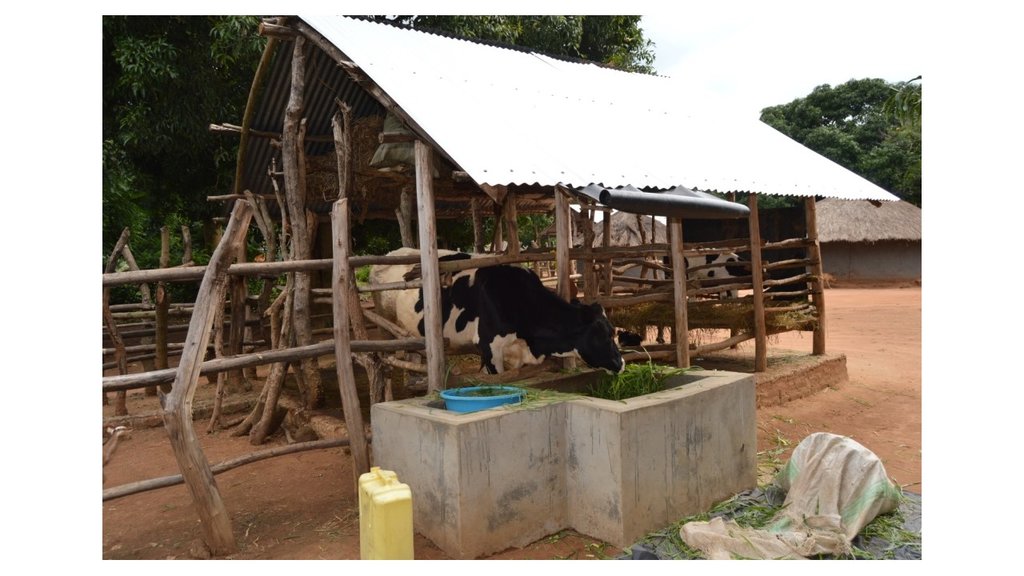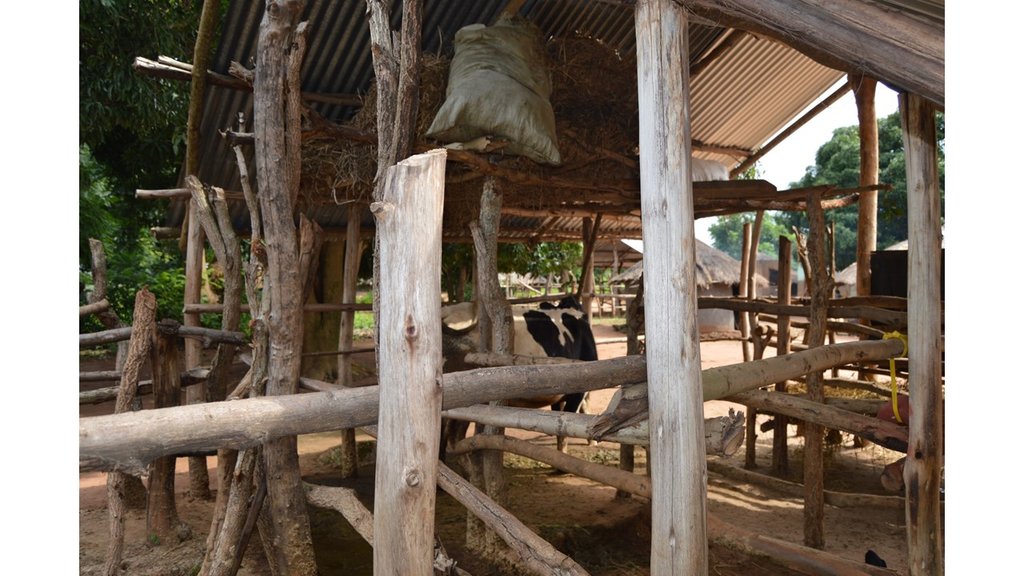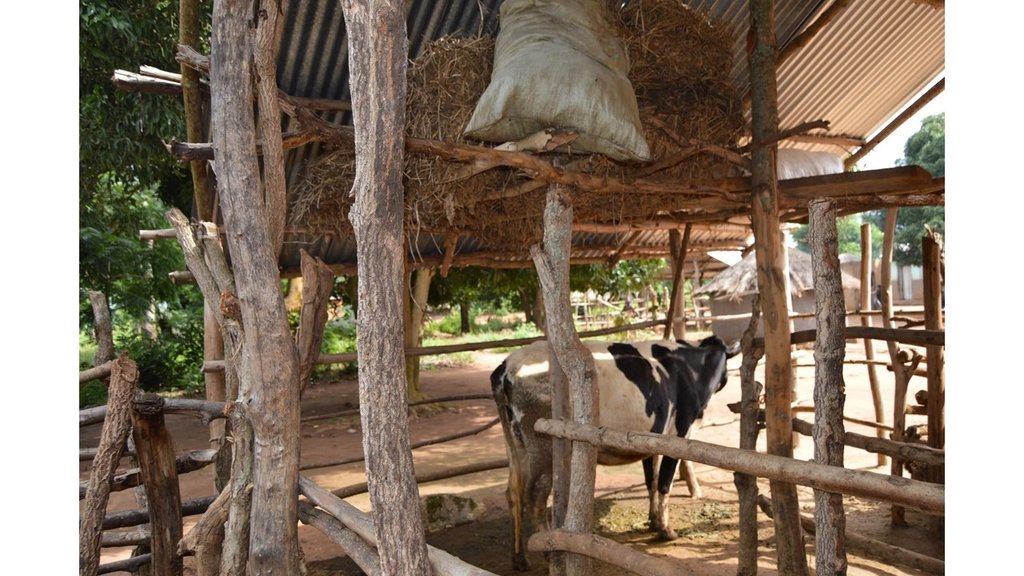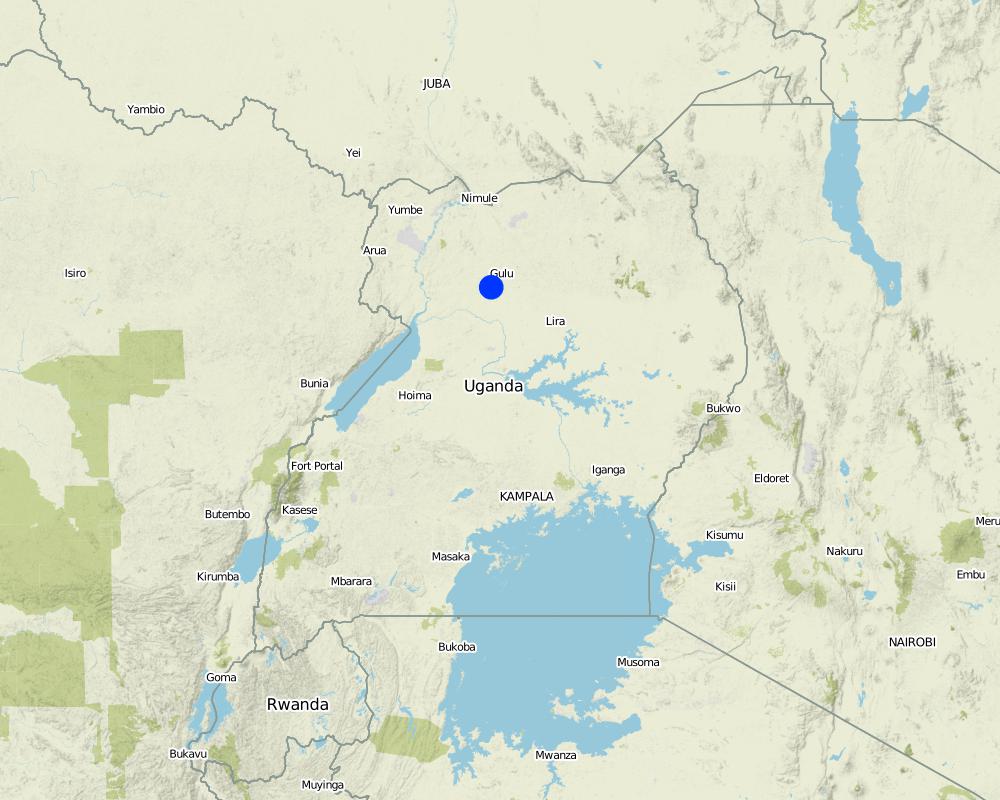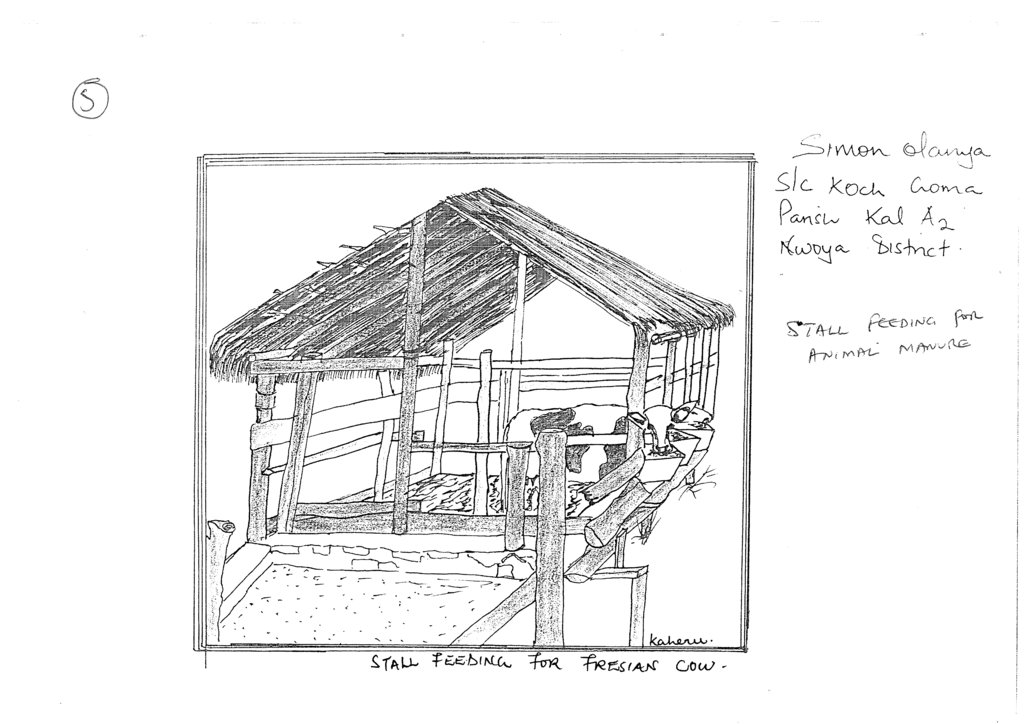Stall feeding of Friesian cow by cut and carry for livestock management [Ouganda]
- Création :
- Mise à jour :
- Compilateur : Kamugisha Rick Nelson
- Rédacteurs : Bernard Fungo, Richard Otto Kawawa, Sunday Balla Amale, JOY TUKAHIRWA
- Examinateurs : Rima Mekdaschi Studer, Stephanie Jaquet, Renate Fleiner, Nicole Harari, John Stephen Tenywa, Donia Mühlematter, Alexandra Gavilano
Gokwo dyang
technologies_2816 - Ouganda
- Résumé complet en PDF
- Résumé complet en PDF pour impression
- Résumé complet dans le navigateur
- Résumé complet (non formaté)
- Stall feeding of Friesian cow by cut and carry for livestock management: 16 juillet 2018 (inactive)
- Stall feeding of Friesian cow by cut and carry for livestock management: 22 mars 2019 (inactive)
- Stall feeding of Friesian cow by cut and carry for livestock management: 22 août 2019 (public)
- Stall feeding of Friesian cow by cut and carry for livestock management: 14 juin 2018 (inactive)
- Stall feeding of Friesian cow for manure: 22 mai 2018 (inactive)
Voir les sections
Développer tout Réduire tout1. Informations générales
1.2 Coordonnées des personnes-ressources et des institutions impliquées dans l'évaluation et la documentation de la Technologie
Personne(s)-ressource(s) clé(s)
exploitant des terres:
Olanya Simon
Farmer
Ouganda
Farmer
Ouganda
Nom du projet qui a facilité la documentation/ l'évaluation de la Technologie (si pertinent)
Scaling-up SLM practices by smallholder farmers (IFAD)Nom du ou des institutions qui ont facilité la documentation/ l'évaluation de la Technologie (si pertinent)
CDE Centre for Development and Environment (CDE Centre for Development and Environment) - Suisse1.3 Conditions relatives à l'utilisation par WOCAT des données documentées
Le compilateur et la(les) personne(s) ressource(s) acceptent les conditions relatives à l'utilisation par WOCAT des données documentées:
Oui
1.4 Déclaration sur la durabilité de la Technologie décrite
Est-ce que la Technologie décrite ici pose problème par rapport à la dégradation des terres, de telle sorte qu'elle ne peut pas être déclarée comme étant une technologie de gestion durable des terres?
Non
2. Description de la Technologie de GDT
2.1 Courte description de la Technologie
Définition de la Technologie:
Zero grazing by cut and carry feeding. The cows do not graze but are confined inside the stall, feed and water is provided for the animals.
2.2 Description détaillée de la Technologie
Description:
Due to land fragmentation and conflicts, traditional grazing systems where animals are reared in open grasslands is no longer feasible and sustainable since grassland is limited and stray animals would destroy neighboring crops. Now small holders with limited land but diversified livelihoods have to utilize the available land in full capacity and sustainable ways. For dairy farmers, stall feeding is an innovative and promising system.
In this practice, a Friesian cow and its calf are confined inside the built stall. The stall has four partitions. A Calf room, milking pallor, feeding and drinking area and sleeping room. Within the feeding area is placed a wooden box of width 0.5m, length 1.5m and height 0.3m; into which feed is put for the animal. A half drum that can hold 80 liters of water is also put inside the feeding area. Both the wooden feeder and half drum are raised to a height of 0.5 m above the ground surface to prevent contamination of the feed with dung and urine; and also ensure efficient feed intake.
The farmer cultivated 1 acre of Napier grass (elephant grass), which provides adequate feed for the demands of the cow (75-100 kg of fresh grass per day). The Napier grass is cut, chopped and put inside the wooden box, while water is fetched from the stream and put into the half drum.
Through this method, the animal movement is restricted. This reduces the exposure to parasites such as ticks, and contagious diseases such as East Coast Fever. This practice also reduces land conflicts that would be caused by stray animals destroying crops of neighbors. The animal does not waste energy to look for pasture and water, hence milk productivity is enhanced. Manure is also deposited within the feeding area and thus easy to collect, decompose and apply in both farmers’ crop and pasture fields. Animals do not need to be attended to, hence farmer has more time to rest and carry out other activities.
However, a lot of labor is required for cutting and chopping the grass, and carrying the feeds and water especially during the dry season. Treatment of animals and maintenance of the stall is costly and if management is poor, parasites and diseases can also build up within the stall. Stall feeding requires feed preservation in the form of fermented pasture (silage) and/or dried pasture (hay); stored and to be used for feeding the animals during dry seasons when pasture is dry and of poor quality.
To sustain this technology, the land users can supplement the feed through cultivating multipurpose tree species (Calliandra spp and Grivellia spp), leguminous forages such as lablab spp and macuna beans. Non-conventional feeds such as kitchen wastes (cassava, sweet potato and banana peelings) can also supplement the cut and carried Napier grass.
2.3 Photos de la Technologie
2.4 Vidéos de la Technologie
Commentaire, brève description:
Video showing Stall feeding for fresian cow for animal manure
Date:
26/05/2017
Lieu:
Kosh village , Goma parish Unyona sub-county , Nwoya District
Nom du vidéaste:
Issa Aiga
2.5 Pays/ région/ lieux où la Technologie a été appliquée et qui sont couverts par cette évaluation
Pays:
Ouganda
Région/ Etat/ Province:
Northern Region,Uganda
Spécifiez la diffusion de la Technologie:
- répartie uniformément sur une zone
S'il n'existe pas d'informations exactes sur la superficie, indiquez les limites approximatives de la zone couverte:
- < 0,1 km2 (10 ha)
Commentaires:
Map showing the technology site in Northern Uganda
Barn, area where napier grass is planted, cut and carried.
Map
×2.6 Date de mise en œuvre de la Technologie
Indiquez l'année de mise en œuvre:
2014
Si l'année précise est inconnue, indiquez la date approximative: :
- il y a moins de 10 ans (récemment)
2.7 Introduction de la Technologie
Spécifiez comment la Technologie a été introduite: :
- par le biais de projets/ d'interventions extérieures
3. Classification de la Technologie de GDT
3.1 Principal(aux) objectif(s) de la Technologie
- créer un impact économique positif
- créer un impact social positif
3.2 Type(s) actuel(s) d'utilisation des terres, là où la Technologie est appliquée

Terres cultivées
- Cultures annuelles
- Plantations d’arbres ou de buissons
- lablab spp and macuna bean
- Calliandra spp and Grivellia spp
Nombre de période de croissance par an: :
- 2

Pâturages
Pâturage intensif/ production fourragère :
- Affouragement en vert/ zéro-pâturage
Type d'animal:
- bétail - laitier
- cow =1 . calf =1
- Fresian cow, milk production, manure and calf.
3.3 Est-ce que l’utilisation des terres a changé en raison de la mise en œuvre de la Technologie ?

Terres cultivées
3.4 Approvisionnement en eau
Approvisionnement en eau des terres sur lesquelles est appliquée la Technologie:
- pluvial
Commentaires:
Use tap water from neighbour(brother) who pump under ground using generator.
Number of growing seasons per year:
2
3.5 Groupe de GDT auquel appartient la Technologie
- gestion intégrée cultures-élevage
- gestion intégrée de la fertilité des sols
- Stall feeding
3.6 Mesures de GDT constituant la Technologie

pratiques agronomiques
- A2: Matière organique/ fertilité du sol

modes de gestion
- M1: Changement du type d’utilisation des terres
- M2: Changement du niveau de gestion / d'intensification

autres mesures
Commentaires:
Cut and carry
3.7 Principaux types de dégradation des terres traités par la Technologie

dégradation chimique des sols
- Cn: baisse de la fertilité des sols et réduction du niveau de matière organique (non causée par l’érosion)

dégradation physique des sols
- Pc: compaction
- Pu: perte de la fonction de bio-production en raison d’autres activités
3.8 Prévention, réduction de la dégradation ou réhabilitation des terres dégradées
Spécifiez l'objectif de la Technologie au regard de la dégradation des terres:
- réduire la dégradation des terres
4. Spécifications techniques, activités, intrants et coûts de mise en œuvre
4.1 Dessin technique de la Technologie
Spécifications techniques (associées au dessin technique):
The stall should be 3 m tall, approximately with 4 rooms 1st floor for calf, second one for milking 3rd for sleeping and the 4th for feeding and drinking water.
The Inputs required for this technology include: concrete wall built with cement, , wood (makonko), grass or iron roof, wooden box of about 1.5x0.5 m, half drum of about 80 litres both raised at 50cm above the floor, rake , tauplin and polythene paper.
Slope: Gentle slope.
Auteur:
Kaheru
Date:
26/05/2017
4.2 Informations générales sur le calcul des intrants et des coûts
Spécifiez la manière dont les coûts et les intrants ont été calculés:
- par superficie de la Technologie
Indiquez la taille et l'unité de surface:
1.5 acres
autre/ monnaie nationale (précisez):
UGX
Indiquez le taux de change des USD en devise locale, le cas échéant (p.ex. 1 USD = 79.9 réal brésilien): 1 USD = :
3803,0
Indiquez le coût salarial moyen de la main d'œuvre par jour:
5000
4.3 Activités de mise en place/ d'établissement
| Activité | Calendrier des activités (saisonnier) | |
|---|---|---|
| 1. | looking for land where to plant pasture | During the first rainy season |
| 2. | Looking for labour to clear the land, planting | Once in a year(April-June) |
| 3. | Looking for seed | once before establsihment |
| 4. | Planting the pasture | Daily after establishment |
| 5. | Initial construction of the stall | Once before establishment |
| 6. | Initial construction of of feeding and drinking troughs | Once before establishment |
| 7. | Putting the cow/s in the stall | Once after establishment |
| 8. | Feeding and watering | Daily |
4.4 Coûts et intrants nécessaires à la mise en place
| Spécifiez les intrants | Unité | Quantité | Coûts par unité | Coût total par intrant | % des coût supporté par les exploitants des terres | |
|---|---|---|---|---|---|---|
| Main d'œuvre | labour for transporting wood and cement | Persons | 25,0 | 5000,0 | 125000,0 | 70,0 |
| Main d'œuvre | Labour for preparing and planting fields | Persons | 45,0 | 5000,0 | 225000,0 | 30,0 |
| Main d'œuvre | Labour for constructing stall | persons | 12,0 | |||
| Equipements | Hoe | Pieces | 2,0 | 10000,0 | 20000,0 | 100,0 |
| Equipements | Panga | Pieces | 1,0 | 7000,0 | 7000,0 | 100,0 |
| Equipements | Spranger | Pieces | 1,0 | 10000,0 | 10000,0 | 100,0 |
| Matériel végétal | Elephant grass | bundles | 5,0 | 100000,0 | 500000,0 | 100,0 |
| Matériel végétal | lab lab | Pieces | 4,0 | 5000,0 | 20000,0 | 100,0 |
| Matériel végétal | Mucuna | Pieces | 1,0 | 20000,0 | 20000,0 | 100,0 |
| Matériaux de construction | Timber | Pieces | 40,0 | 3000,0 | 120000,0 | 100,0 |
| Matériaux de construction | Cement | bags | 10,0 | 30000,0 | 300000,0 | 100,0 |
| Matériaux de construction | Logs | Pieces | 60,0 | 3000,0 | 180000,0 | 100,0 |
| Matériaux de construction | Nails | kgs | 10,0 | 3500,0 | 35000,0 | 100,0 |
| Autre | Grass to thatch the stall | bundles | 24,0 | 2000,0 | 48000,0 | 100,0 |
| Coût total de mise en place de la Technologie | 1610000,0 | |||||
| Coût total de mise en place de la Technologie en dollars américains (USD) | 423,35 | |||||
Commentaires:
Some seed like Macuna and brucheria was provided for free
4.5 Activités d'entretien/ récurrentes
| Activité | Calendrier/ fréquence | |
|---|---|---|
| 1. | Weeding pasture | Three times per year |
| 2. | Repairing of stall | once after establishment and when need |
| 3. | Treatment of cow | When need arises(sick) |
| 4. | Insemination | Once in two years |
| 5. | Spraying | Twice per week |
| 6. | Reseeding | During the rainy season |
| 7. | Replanting of pasture | During the rainy season |
| 8. | Cutting and carrying the grass to the animal | Daily after establishment |
| 9. | Collection of manure | Daily |
| 10. | Applying manure to the garden | Daily |
| 11. | Making silage and hay | During the wet season |
4.6 Coûts et intrants nécessaires aux activités d'entretien/ récurrentes (par an)
| Spécifiez les intrants | Unité | Quantité | Coûts par unité | Coût total par intrant | % des coût supporté par les exploitants des terres | |
|---|---|---|---|---|---|---|
| Main d'œuvre | Labour on daily basis | Persons | 3,0 | 5000,0 | 15000,0 | 70,0 |
| Main d'œuvre | Hired labour on monthly basis | Persons | 2,0 | 150000,0 | 300000,0 | 30,0 |
| Equipements | Hoe | Pieces | 10,0 | 10000,0 | 100000,0 | 100,0 |
| Equipements | Rake | Pieces | 2,0 | 7000,0 | 14000,0 | 100,0 |
| Equipements | Tauplin | Pieces | 1,0 | 35000,0 | 35000,0 | 100,0 |
| Equipements | Polythene | Rolls | 1,0 | 25000,0 | 25000,0 | 100,0 |
| Matériel végétal | pasture for planting | Bundles | 43,0 | 10000,0 | 430000,0 | 100,0 |
| Autre | Pesticides (monthly) | litres | 2,0 | 12000,0 | 24000,0 | 100,0 |
| Coût total d'entretien de la Technologie | 943000,0 | |||||
| Coût total d'entretien de la Technologie en dollars américains (USD) | 247,96 | |||||
4.7 Facteurs les plus importants affectant les coûts
Décrivez les facteurs les plus importants affectant les coûts :
Labour costs for establishing and maintaining the technology.
5. Environnement naturel et humain
5.1 Climat
Précipitations annuelles
- < 250 mm
- 251-500 mm
- 501-750 mm
- 751-1000 mm
- 1001-1500 mm
- 1501-2000 mm
- 2001-3000 mm
- 3001-4000 mm
- > 4000 mm
Spécifiez la pluviométrie moyenne annuelle (si connue), en mm:
1500,00
Spécifications/ commentaires sur les précipitations:
Two rainy season separated by about two weeks and dry spell and dry season of 4 weeks.
Zone agro-climatique
- subhumide
5.2 Topographie
Pentes moyennes:
- plat (0-2 %)
- faible (3-5%)
- modéré (6-10%)
- onduleux (11-15%)
- vallonné (16-30%)
- raide (31-60%)
- très raide (>60%)
Reliefs:
- plateaux/ plaines
- crêtes
- flancs/ pentes de montagne
- flancs/ pentes de colline
- piémonts/ glacis (bas de pente)
- fonds de vallée/bas-fonds
Zones altitudinales:
- 0-100 m
- 101-500 m
- 501-1000 m
- 1001-1500 m
- 1501-2000 m
- 2001-2500 m
- 2501-3000 m
- 3001-4000 m
- > 4000 m
Indiquez si la Technologie est spécifiquement appliquée dans des:
- non pertinent
5.3 Sols
Profondeur moyenne du sol:
- très superficiel (0-20 cm)
- superficiel (21-50 cm)
- modérément profond (51-80 cm)
- profond (81-120 cm)
- très profond (>120 cm)
Texture du sol (de la couche arable):
- moyen (limoneux)
Texture du sol (> 20 cm sous la surface):
- fin/ lourd (argile)
Matière organique de la couche arable:
- moyen (1-3%)
5.4 Disponibilité et qualité de l'eau
Profondeur estimée de l’eau dans le sol:
5-50 m
Disponibilité de l’eau de surface:
moyenne
Qualité de l’eau (non traitée):
eau potable
La salinité de l'eau est-elle un problème? :
Non
La zone est-elle inondée?
Non
5.5 Biodiversité
Diversité des espèces:
- faible
Diversité des habitats:
- faible
5.6 Caractéristiques des exploitants des terres appliquant la Technologie
Sédentaire ou nomade:
- Sédentaire
Orientation du système de production:
- exploitation mixte (de subsistance/ commerciale)
Revenus hors exploitation:
- moins de 10% de tous les revenus
Niveau relatif de richesse:
- moyen
Individus ou groupes:
- individu/ ménage
Niveau de mécanisation:
- travail manuel
Genre:
- femmes
- hommes
Age des exploitants des terres:
- jeunes
- personnes d'âge moyen
5.7 Superficie moyenne des terres utilisées par les exploitants des terres appliquant la Technologie
- < 0,5 ha
- 0,5-1 ha
- 1-2 ha
- 2-5 ha
- 5-15 ha
- 15-50 ha
- 50-100 ha
- 100-500 ha
- 500-1 000 ha
- 1 000-10 000 ha
- > 10 000 ha
Cette superficie est-elle considérée comme de petite, moyenne ou grande dimension (en se référant au contexte local)?
- moyenne dimension
Commentaires:
Inherited land
5.8 Propriété foncière, droits d’utilisation des terres et de l'eau
Propriété foncière:
- individu, sans titre de propriété
Droits d’utilisation des terres:
- individuel
Droits d’utilisation de l’eau:
- communautaire (organisé)
5.9 Accès aux services et aux infrastructures
santé:
- pauvre
- modéré
- bonne
éducation:
- pauvre
- modéré
- bonne
assistance technique:
- pauvre
- modéré
- bonne
emploi (par ex. hors exploitation):
- pauvre
- modéré
- bonne
marchés:
- pauvre
- modéré
- bonne
énergie:
- pauvre
- modéré
- bonne
routes et transports:
- pauvre
- modéré
- bonne
eau potable et assainissement:
- pauvre
- modéré
- bonne
services financiers:
- pauvre
- modéré
- bonne
6. Impacts et conclusions
6.1 Impacts sur site que la Technologie a montrés
Impacts socio-économiques
Production
production agricole
Commentaires/ spécifiez:
The area which is under pasture.
production fourragère
Commentaires/ spécifiez:
0.5 acre improved pasture but lack management.
production animale
Quantité avant la GDT:
3 litres of milk per day
Quantité après la GDT:
10litres of milk per day
Commentaires/ spécifiez:
Increased milk production.
surface de production
Commentaires/ spécifiez:
Additional fodder.
gestion des terres
Commentaires/ spécifiez:
Trees hold soils , are perennial as compared to annuals that need to be planted every year and need less maintenance.
Disponibilité et qualité de l'eau
qualité de l'eau pour l'élevage
Commentaires/ spécifiez:
But it has no much effect.
Revenus et coûts
dépenses pour les intrants agricoles
Commentaires/ spécifiez:
Planting material.
revenus agricoles
Commentaires/ spécifiez:
Sale of milk.
diversité des sources de revenus
Commentaires/ spécifiez:
More products for sale (grass, milk, manure).
charge de travail
Commentaires/ spécifiez:
Feeding animal.
Impacts socioculturels
sécurité alimentaire/ autosuffisance
Commentaires/ spécifiez:
Income received from sale of milk is used for buying food.
institutions communautaires
Commentaires/ spécifiez:
Especially in savings and credit (SACCO).
Impacts écologiques
Sols
perte en sol
Commentaires/ spécifiez:
Restricted movements of cattle since the ve is only cut and carried to where the animal is fed.
compaction du sol
Commentaires/ spécifiez:
Less tampering with the soil.
matière organique du sol/ au dessous du sol C
Commentaires/ spécifiez:
Due to application of manure.
6.2 Impacts hors site que la Technologie a montrés
dommages sur les champs voisins
Commentaires/ spécifiez:
No zero grazing.
impact des gaz à effet de serre
Commentaires/ spécifiez:
No bio gas production.
6.3 Exposition et sensibilité de la Technologie aux changements progressifs et aux évènements extrêmes/catastrophes liés au climat (telles que perçues par les exploitants des terres)
Changements climatiques progressifs
Changements climatiques progressifs
| Saison | Augmentation ou diminution | Comment la Technologie fait-elle face à cela? | |
|---|---|---|---|
| températures annuelles | augmente | modérément |
Commentaires:
The land user requires more knowledge and skills for sustainability of this technology.
6.4 Analyse coûts-bénéfices
Quels sont les bénéfices comparativement aux coûts de mise en place (du point de vue des exploitants des terres)?
Rentabilité à court terme:
positive
Rentabilité à long terme:
très positive
Quels sont les bénéfices comparativement aux coûts d'entretien récurrents (du point de vue des exploitants des terres)?
Rentabilité à court terme:
positive
Rentabilité à long terme:
très positive
Commentaires:
Once established the farmer needs only to pay for labour to cut and carry grass and make silage and hay only.
6.5 Adoption de la Technologie
- 1-10%
De tous ceux qui ont adopté la Technologie, combien d'entre eux l'ont fait spontanément, à savoir sans recevoir aucune incitation matérielle, ou aucune rémunération? :
- 0-10%
Commentaires:
Motivated by NGO.
6.6 Adaptation
La Technologie a-t-elle été récemment modifiée pour s'adapter à l'évolution des conditions?
Oui
Si oui, indiquez à quel changement la Technologie s'est adaptée:
- changements/ extrêmes climatiques
Spécifiez l'adaptation de la Technologie (conception, matériaux/ espèces, etc.):
During the dry season, the land user seeks fodder from the swamps.
6.7 Points forts/ avantages/ possibilités de la Technologie
| Points forts/ avantages/ possibilités du point de vue de l'exploitant des terres |
|---|
| The technology is good at providing income for household needs. |
| The technology is replicable in other areas and helps diversify income source because of the many products derived from the technology. |
| Does not require labour to attend to it for 12 hours in a day unlike those technologies that concern cultivation. This means the farmer has more time to do other activities in a day. |
| Points forts/ avantages/ possibilités du point de vue du compilateur ou d'une autre personne ressource clé |
|---|
| Appropriate for low maintenance costs. |
| The technology does not promote conflicts among land users. |
6.8 Faiblesses/ inconvénients/ risques de la Technologie et moyens de les surmonter
| Faiblesses/ inconvénients/ risques du point de vue de l’exploitant des terres | Comment peuvent-ils être surmontés? |
|---|---|
| High costs of treatment. | Reduce risk of infection and infestation. |
| Veterinary services expensive and not easily available. | Training of local trainers to support extension. |
| Faiblesses/ inconvénients/ risques du point de vue du compilateur ou d'une autre personne ressource clé | Comment peuvent-ils être surmontés? |
|---|---|
| The technology is not sustainable if not well manged by the land user. | Improve management of the technology. |
| Requires day to day monitoring of diseases. | Engage household labour to keep alternating. |
| The land user require skills on how to make concentrates. | Train the land user on how to make concentrates. |
7. Références et liens
7.1 Méthodes/ sources d'information
- visites de terrain, enquêtes sur le terrain
01
- interviews/entretiens avec les exploitants des terres
01
Quand les données ont-elles été compilées (sur le terrain)?
24/05/2017
Liens et modules
Développer tout Réduire toutLiens
Aucun lien
Modules
Aucun module trouvé


